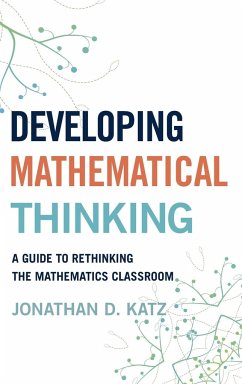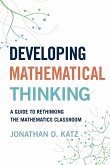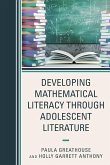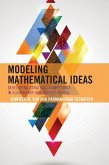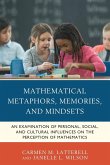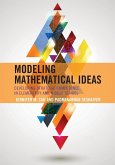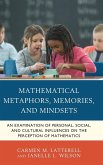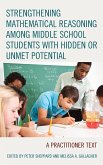- Gebundenes Buch
- Merkliste
- Auf die Merkliste
- Bewerten Bewerten
- Teilen
- Produkt teilen
- Produkterinnerung
- Produkterinnerung
The goal of this book is to begin to change the way students experience mathematics in the middle and high school classrooms. In this book you will find a theoretical basis for this approach to teaching mathematics, multiple guides and questions for teachers to think about in relation to their everyday teaching, and over 30 examples of problems, lessons, tasks, and projects that been used effectively with urban students.
Andere Kunden interessierten sich auch für
![Developing Mathematical Thinking Developing Mathematical Thinking]() Jonathan D. KatzDeveloping Mathematical Thinking51,99 €
Jonathan D. KatzDeveloping Mathematical Thinking51,99 €![Developing Mathematical Literacy through Adolescent Literature Developing Mathematical Literacy through Adolescent Literature]() Developing Mathematical Literacy through Adolescent Literature42,99 €
Developing Mathematical Literacy through Adolescent Literature42,99 €![Modeling Mathematical Ideas Modeling Mathematical Ideas]() Jennifer M. SuhModeling Mathematical Ideas117,99 €
Jennifer M. SuhModeling Mathematical Ideas117,99 €![Mathematical Metaphors, Memories, and Mindsets Mathematical Metaphors, Memories, and Mindsets]() Carmen M. LatterellMathematical Metaphors, Memories, and Mindsets37,99 €
Carmen M. LatterellMathematical Metaphors, Memories, and Mindsets37,99 €![Modeling Mathematical Ideas Modeling Mathematical Ideas]() Jennifer M. SuhModeling Mathematical Ideas60,99 €
Jennifer M. SuhModeling Mathematical Ideas60,99 €![Mathematical Metaphors, Memories, and Mindsets Mathematical Metaphors, Memories, and Mindsets]() Carmen M. LatterellMathematical Metaphors, Memories, and Mindsets68,99 €
Carmen M. LatterellMathematical Metaphors, Memories, and Mindsets68,99 €![Strengthening Mathematical Reasoning among Middle School Students with Hidden or Unmet Potential Strengthening Mathematical Reasoning among Middle School Students with Hidden or Unmet Potential]() Strengthening Mathematical Reasoning among Middle School Students with Hidden or Unmet Potential78,99 €
Strengthening Mathematical Reasoning among Middle School Students with Hidden or Unmet Potential78,99 €-
-
-
The goal of this book is to begin to change the way students experience mathematics in the middle and high school classrooms. In this book you will find a theoretical basis for this approach to teaching mathematics, multiple guides and questions for teachers to think about in relation to their everyday teaching, and over 30 examples of problems, lessons, tasks, and projects that been used effectively with urban students.
Hinweis: Dieser Artikel kann nur an eine deutsche Lieferadresse ausgeliefert werden.
Hinweis: Dieser Artikel kann nur an eine deutsche Lieferadresse ausgeliefert werden.
Produktdetails
- Produktdetails
- Verlag: Rowman & Littlefield Publishers
- Seitenzahl: 144
- Erscheinungstermin: 9. Juli 2014
- Englisch
- Abmessung: 235mm x 157mm x 13mm
- Gewicht: 370g
- ISBN-13: 9781475810561
- ISBN-10: 1475810563
- Artikelnr.: 40555882
- Herstellerkennzeichnung
- Libri GmbH
- Europaallee 1
- 36244 Bad Hersfeld
- gpsr@libri.de
- Verlag: Rowman & Littlefield Publishers
- Seitenzahl: 144
- Erscheinungstermin: 9. Juli 2014
- Englisch
- Abmessung: 235mm x 157mm x 13mm
- Gewicht: 370g
- ISBN-13: 9781475810561
- ISBN-10: 1475810563
- Artikelnr.: 40555882
- Herstellerkennzeichnung
- Libri GmbH
- Europaallee 1
- 36244 Bad Hersfeld
- gpsr@libri.de
By Jonathan D. Katz
Preface Introduction What Will You Find in This Book Chapter 1: An
Explanation of the ISA Approach to Teaching and Learning Mathematics
Introduction A Vision of Mathematics in an ISA Classroom Guide To Creating
a Vision and Four-Year Plan ISA Mathematics Rubric Indicators of Teacher
Instructional Practices That Elicit Student Mathematical Thinking
Indicators of Student Demonstration of Mathematical Thinking Chapter 2: A
Guide to Teaching and Learning Mathematics Using the Five Dimensions of the
ISA Rubric Introduction Dimension 1: Problem Solving Problem Solving
Definition and Overview Teaching Idea #1: Choosing the Appropriate Problem
Teaching Idea #2A: Use Problems with Multiple Strategies Teaching Idea #2B:
Selecting an Appropriate Strategy Teaching Idea #3: Value Process and
Answer Teaching Idea #4: Answer Student Questions to Foster Understanding
Teaching Idea #5: Error as a Tool for Inquiry Teaching Idea #6: Students
Create Their Own Problems Dimension II: Reasoning and Proof Reasoning and
Proof Definitions and Overview Teaching Idea #1: Conjecturing Teaching Idea
#2: Evidence and Proof Teaching Idea #3: Metacognition Dimension III:
Communication Communication Definition and Overview Teaching Idea #1:
Writing in Journals Teaching Idea #2: Writing in Problems and Projects
Teaching Idea #3: Oral Communication Dimension IV: Connections Connections
Definition and OverviewX Teaching Idea #1: There Are Common Structures That
Bind Together the Multiple Ideas of Mathematics Teaching Idea #2: The
History of Mathematics Helps Students Make Sense of and Appreciate
Mathematics Teaching Idea #3: Using Contextual Problems That Are Meaningful
to Students Dimension V: Representation Representation Definition and
Overview Teaching Idea #1A: Learning to Abstract - Moving from Arithmetic
to Algebra Teaching Idea #1B: Learning to Abstract - Use Examples of
Physical Structures Teaching Idea #2: Making Sense of Confusion to Solve
Problems Teaching Idea #3: Interpreting and Explaining Teaching Idea #4A:
Mathematical Modeling - Modeling Mathematical Ideas and Real World
Situations Teaching Idea #4B: Mathematical Modeling - Projects of the World
That Use Rich Mathematics Chapter 3: Problems, Investigations, Lessons,
Projects, and Performance Tasks Introduction Example 1: Display Dilemma
Problem - Using Multiple Strategies / Looking for Patterns Example 2:
Shakira's Number - Valuing Process Example 3: Crossing the River - Valuing
Process Example 4: Checker Board Problem - Simplifying the Problem Example
5: When Can I Divide? - Using Errors as a Tool of Inquiry Example 6:
Creating a Mathematical Situation: Three Examples - Students Create Their
Own Problems Example 7: The Game of 27 - Reasoning and Conjecturing Example
8: The String Problem - Conjecturing Example 9: Congruence and Similarity -
Conjecturing and Proof Example 10: The Race - Metacognition on Multiple
Strategies Example 11: Murder Mystery - Evidence and Proof Example 12: The
Locker Problem - Metacognition Example 13: Gaming the Dice - Writing in
Problems Example 14: Does Penelope Crash Into Mars? - Problems Are
Meaningful to Students Example 15: Consecutive Sums Problem - Patterns and
Conjecturing Example 16: Activity to Lead to Definition and Multiple
Representations of a Function - Structures in Mathematics Example 17: The
Pythagorean Triplets - The History of Mathematics Example 18: Laws of
Exponents - Moving From Arithmetic to Algebra Example 19: Working with
Variables - Learning to Abstract: Moving from Arithmetic to Algebra Example
20: Models of the Seagram Building - Use of Physical Structures Example 21:
How Tall Is Your School Building? - Use of Physical Structures Example 22:
Model Suspension Bridge Project - Modeling Real World Situations Example
23: Shoe Size Problem - Modeling Real World Situations Example 24: The Peg
Game - Using Games to Understand Mathematics Example 25: Concentration of
Medication in a Patient's Blood Over Time - Modeling Using Real World Data
Example 26: Marcella's Bagels - Working Backwards Example 27: What is
normal? - Modeling Mathematical Ideas and Real World Situations Example 28:
Can You Build the Most Efficient Container? - Mathematical Modeling Example
29: Salary Choice - Mathematical Modeling Example 30: Border Problem -
Learning to Abstract: Moving from Arithmetic to Algebra Example 31: The
Magical Exterior Angles - Encouraging the Use of Evidence and Proof in
Daily Problem Solving Example 32: Creating a Fair Game - Projects of the
World That Use Rich Mathematics Chapter 4: Various Guides for Teachers
Introduction School Mathematics: A Self-Assessment What Does An Inquiry
Process Look Like In Mathematics? How to Write an Inquiry Lesson Questions
to Think About When Planning an Inquiry-Based Common Core Aligned Unit List
of Questions to Think About When Writing a Mathematical Performance Task
Guide to Writing an Inquiry Lesson Inquiry-Based Lesson Planning Template
Big Ideas in Algebra Big Ideas in Geometry Big Ideas in Probability and
Statistics Questions for Students to Ask Themselves When Solving a Problem
An Inquiry Approach to Look at Student Work An Inquiry Approach to Look at
a Teacher-Created Task, Activity, or Lesson Teacher's Perceptions Continuum
Student's Perceptions Continuum School Mathematics: A Self-Assessment
References
Explanation of the ISA Approach to Teaching and Learning Mathematics
Introduction A Vision of Mathematics in an ISA Classroom Guide To Creating
a Vision and Four-Year Plan ISA Mathematics Rubric Indicators of Teacher
Instructional Practices That Elicit Student Mathematical Thinking
Indicators of Student Demonstration of Mathematical Thinking Chapter 2: A
Guide to Teaching and Learning Mathematics Using the Five Dimensions of the
ISA Rubric Introduction Dimension 1: Problem Solving Problem Solving
Definition and Overview Teaching Idea #1: Choosing the Appropriate Problem
Teaching Idea #2A: Use Problems with Multiple Strategies Teaching Idea #2B:
Selecting an Appropriate Strategy Teaching Idea #3: Value Process and
Answer Teaching Idea #4: Answer Student Questions to Foster Understanding
Teaching Idea #5: Error as a Tool for Inquiry Teaching Idea #6: Students
Create Their Own Problems Dimension II: Reasoning and Proof Reasoning and
Proof Definitions and Overview Teaching Idea #1: Conjecturing Teaching Idea
#2: Evidence and Proof Teaching Idea #3: Metacognition Dimension III:
Communication Communication Definition and Overview Teaching Idea #1:
Writing in Journals Teaching Idea #2: Writing in Problems and Projects
Teaching Idea #3: Oral Communication Dimension IV: Connections Connections
Definition and OverviewX Teaching Idea #1: There Are Common Structures That
Bind Together the Multiple Ideas of Mathematics Teaching Idea #2: The
History of Mathematics Helps Students Make Sense of and Appreciate
Mathematics Teaching Idea #3: Using Contextual Problems That Are Meaningful
to Students Dimension V: Representation Representation Definition and
Overview Teaching Idea #1A: Learning to Abstract - Moving from Arithmetic
to Algebra Teaching Idea #1B: Learning to Abstract - Use Examples of
Physical Structures Teaching Idea #2: Making Sense of Confusion to Solve
Problems Teaching Idea #3: Interpreting and Explaining Teaching Idea #4A:
Mathematical Modeling - Modeling Mathematical Ideas and Real World
Situations Teaching Idea #4B: Mathematical Modeling - Projects of the World
That Use Rich Mathematics Chapter 3: Problems, Investigations, Lessons,
Projects, and Performance Tasks Introduction Example 1: Display Dilemma
Problem - Using Multiple Strategies / Looking for Patterns Example 2:
Shakira's Number - Valuing Process Example 3: Crossing the River - Valuing
Process Example 4: Checker Board Problem - Simplifying the Problem Example
5: When Can I Divide? - Using Errors as a Tool of Inquiry Example 6:
Creating a Mathematical Situation: Three Examples - Students Create Their
Own Problems Example 7: The Game of 27 - Reasoning and Conjecturing Example
8: The String Problem - Conjecturing Example 9: Congruence and Similarity -
Conjecturing and Proof Example 10: The Race - Metacognition on Multiple
Strategies Example 11: Murder Mystery - Evidence and Proof Example 12: The
Locker Problem - Metacognition Example 13: Gaming the Dice - Writing in
Problems Example 14: Does Penelope Crash Into Mars? - Problems Are
Meaningful to Students Example 15: Consecutive Sums Problem - Patterns and
Conjecturing Example 16: Activity to Lead to Definition and Multiple
Representations of a Function - Structures in Mathematics Example 17: The
Pythagorean Triplets - The History of Mathematics Example 18: Laws of
Exponents - Moving From Arithmetic to Algebra Example 19: Working with
Variables - Learning to Abstract: Moving from Arithmetic to Algebra Example
20: Models of the Seagram Building - Use of Physical Structures Example 21:
How Tall Is Your School Building? - Use of Physical Structures Example 22:
Model Suspension Bridge Project - Modeling Real World Situations Example
23: Shoe Size Problem - Modeling Real World Situations Example 24: The Peg
Game - Using Games to Understand Mathematics Example 25: Concentration of
Medication in a Patient's Blood Over Time - Modeling Using Real World Data
Example 26: Marcella's Bagels - Working Backwards Example 27: What is
normal? - Modeling Mathematical Ideas and Real World Situations Example 28:
Can You Build the Most Efficient Container? - Mathematical Modeling Example
29: Salary Choice - Mathematical Modeling Example 30: Border Problem -
Learning to Abstract: Moving from Arithmetic to Algebra Example 31: The
Magical Exterior Angles - Encouraging the Use of Evidence and Proof in
Daily Problem Solving Example 32: Creating a Fair Game - Projects of the
World That Use Rich Mathematics Chapter 4: Various Guides for Teachers
Introduction School Mathematics: A Self-Assessment What Does An Inquiry
Process Look Like In Mathematics? How to Write an Inquiry Lesson Questions
to Think About When Planning an Inquiry-Based Common Core Aligned Unit List
of Questions to Think About When Writing a Mathematical Performance Task
Guide to Writing an Inquiry Lesson Inquiry-Based Lesson Planning Template
Big Ideas in Algebra Big Ideas in Geometry Big Ideas in Probability and
Statistics Questions for Students to Ask Themselves When Solving a Problem
An Inquiry Approach to Look at Student Work An Inquiry Approach to Look at
a Teacher-Created Task, Activity, or Lesson Teacher's Perceptions Continuum
Student's Perceptions Continuum School Mathematics: A Self-Assessment
References
Preface Introduction What Will You Find in This Book Chapter 1: An
Explanation of the ISA Approach to Teaching and Learning Mathematics
Introduction A Vision of Mathematics in an ISA Classroom Guide To Creating
a Vision and Four-Year Plan ISA Mathematics Rubric Indicators of Teacher
Instructional Practices That Elicit Student Mathematical Thinking
Indicators of Student Demonstration of Mathematical Thinking Chapter 2: A
Guide to Teaching and Learning Mathematics Using the Five Dimensions of the
ISA Rubric Introduction Dimension 1: Problem Solving Problem Solving
Definition and Overview Teaching Idea #1: Choosing the Appropriate Problem
Teaching Idea #2A: Use Problems with Multiple Strategies Teaching Idea #2B:
Selecting an Appropriate Strategy Teaching Idea #3: Value Process and
Answer Teaching Idea #4: Answer Student Questions to Foster Understanding
Teaching Idea #5: Error as a Tool for Inquiry Teaching Idea #6: Students
Create Their Own Problems Dimension II: Reasoning and Proof Reasoning and
Proof Definitions and Overview Teaching Idea #1: Conjecturing Teaching Idea
#2: Evidence and Proof Teaching Idea #3: Metacognition Dimension III:
Communication Communication Definition and Overview Teaching Idea #1:
Writing in Journals Teaching Idea #2: Writing in Problems and Projects
Teaching Idea #3: Oral Communication Dimension IV: Connections Connections
Definition and OverviewX Teaching Idea #1: There Are Common Structures That
Bind Together the Multiple Ideas of Mathematics Teaching Idea #2: The
History of Mathematics Helps Students Make Sense of and Appreciate
Mathematics Teaching Idea #3: Using Contextual Problems That Are Meaningful
to Students Dimension V: Representation Representation Definition and
Overview Teaching Idea #1A: Learning to Abstract - Moving from Arithmetic
to Algebra Teaching Idea #1B: Learning to Abstract - Use Examples of
Physical Structures Teaching Idea #2: Making Sense of Confusion to Solve
Problems Teaching Idea #3: Interpreting and Explaining Teaching Idea #4A:
Mathematical Modeling - Modeling Mathematical Ideas and Real World
Situations Teaching Idea #4B: Mathematical Modeling - Projects of the World
That Use Rich Mathematics Chapter 3: Problems, Investigations, Lessons,
Projects, and Performance Tasks Introduction Example 1: Display Dilemma
Problem - Using Multiple Strategies / Looking for Patterns Example 2:
Shakira's Number - Valuing Process Example 3: Crossing the River - Valuing
Process Example 4: Checker Board Problem - Simplifying the Problem Example
5: When Can I Divide? - Using Errors as a Tool of Inquiry Example 6:
Creating a Mathematical Situation: Three Examples - Students Create Their
Own Problems Example 7: The Game of 27 - Reasoning and Conjecturing Example
8: The String Problem - Conjecturing Example 9: Congruence and Similarity -
Conjecturing and Proof Example 10: The Race - Metacognition on Multiple
Strategies Example 11: Murder Mystery - Evidence and Proof Example 12: The
Locker Problem - Metacognition Example 13: Gaming the Dice - Writing in
Problems Example 14: Does Penelope Crash Into Mars? - Problems Are
Meaningful to Students Example 15: Consecutive Sums Problem - Patterns and
Conjecturing Example 16: Activity to Lead to Definition and Multiple
Representations of a Function - Structures in Mathematics Example 17: The
Pythagorean Triplets - The History of Mathematics Example 18: Laws of
Exponents - Moving From Arithmetic to Algebra Example 19: Working with
Variables - Learning to Abstract: Moving from Arithmetic to Algebra Example
20: Models of the Seagram Building - Use of Physical Structures Example 21:
How Tall Is Your School Building? - Use of Physical Structures Example 22:
Model Suspension Bridge Project - Modeling Real World Situations Example
23: Shoe Size Problem - Modeling Real World Situations Example 24: The Peg
Game - Using Games to Understand Mathematics Example 25: Concentration of
Medication in a Patient's Blood Over Time - Modeling Using Real World Data
Example 26: Marcella's Bagels - Working Backwards Example 27: What is
normal? - Modeling Mathematical Ideas and Real World Situations Example 28:
Can You Build the Most Efficient Container? - Mathematical Modeling Example
29: Salary Choice - Mathematical Modeling Example 30: Border Problem -
Learning to Abstract: Moving from Arithmetic to Algebra Example 31: The
Magical Exterior Angles - Encouraging the Use of Evidence and Proof in
Daily Problem Solving Example 32: Creating a Fair Game - Projects of the
World That Use Rich Mathematics Chapter 4: Various Guides for Teachers
Introduction School Mathematics: A Self-Assessment What Does An Inquiry
Process Look Like In Mathematics? How to Write an Inquiry Lesson Questions
to Think About When Planning an Inquiry-Based Common Core Aligned Unit List
of Questions to Think About When Writing a Mathematical Performance Task
Guide to Writing an Inquiry Lesson Inquiry-Based Lesson Planning Template
Big Ideas in Algebra Big Ideas in Geometry Big Ideas in Probability and
Statistics Questions for Students to Ask Themselves When Solving a Problem
An Inquiry Approach to Look at Student Work An Inquiry Approach to Look at
a Teacher-Created Task, Activity, or Lesson Teacher's Perceptions Continuum
Student's Perceptions Continuum School Mathematics: A Self-Assessment
References
Explanation of the ISA Approach to Teaching and Learning Mathematics
Introduction A Vision of Mathematics in an ISA Classroom Guide To Creating
a Vision and Four-Year Plan ISA Mathematics Rubric Indicators of Teacher
Instructional Practices That Elicit Student Mathematical Thinking
Indicators of Student Demonstration of Mathematical Thinking Chapter 2: A
Guide to Teaching and Learning Mathematics Using the Five Dimensions of the
ISA Rubric Introduction Dimension 1: Problem Solving Problem Solving
Definition and Overview Teaching Idea #1: Choosing the Appropriate Problem
Teaching Idea #2A: Use Problems with Multiple Strategies Teaching Idea #2B:
Selecting an Appropriate Strategy Teaching Idea #3: Value Process and
Answer Teaching Idea #4: Answer Student Questions to Foster Understanding
Teaching Idea #5: Error as a Tool for Inquiry Teaching Idea #6: Students
Create Their Own Problems Dimension II: Reasoning and Proof Reasoning and
Proof Definitions and Overview Teaching Idea #1: Conjecturing Teaching Idea
#2: Evidence and Proof Teaching Idea #3: Metacognition Dimension III:
Communication Communication Definition and Overview Teaching Idea #1:
Writing in Journals Teaching Idea #2: Writing in Problems and Projects
Teaching Idea #3: Oral Communication Dimension IV: Connections Connections
Definition and OverviewX Teaching Idea #1: There Are Common Structures That
Bind Together the Multiple Ideas of Mathematics Teaching Idea #2: The
History of Mathematics Helps Students Make Sense of and Appreciate
Mathematics Teaching Idea #3: Using Contextual Problems That Are Meaningful
to Students Dimension V: Representation Representation Definition and
Overview Teaching Idea #1A: Learning to Abstract - Moving from Arithmetic
to Algebra Teaching Idea #1B: Learning to Abstract - Use Examples of
Physical Structures Teaching Idea #2: Making Sense of Confusion to Solve
Problems Teaching Idea #3: Interpreting and Explaining Teaching Idea #4A:
Mathematical Modeling - Modeling Mathematical Ideas and Real World
Situations Teaching Idea #4B: Mathematical Modeling - Projects of the World
That Use Rich Mathematics Chapter 3: Problems, Investigations, Lessons,
Projects, and Performance Tasks Introduction Example 1: Display Dilemma
Problem - Using Multiple Strategies / Looking for Patterns Example 2:
Shakira's Number - Valuing Process Example 3: Crossing the River - Valuing
Process Example 4: Checker Board Problem - Simplifying the Problem Example
5: When Can I Divide? - Using Errors as a Tool of Inquiry Example 6:
Creating a Mathematical Situation: Three Examples - Students Create Their
Own Problems Example 7: The Game of 27 - Reasoning and Conjecturing Example
8: The String Problem - Conjecturing Example 9: Congruence and Similarity -
Conjecturing and Proof Example 10: The Race - Metacognition on Multiple
Strategies Example 11: Murder Mystery - Evidence and Proof Example 12: The
Locker Problem - Metacognition Example 13: Gaming the Dice - Writing in
Problems Example 14: Does Penelope Crash Into Mars? - Problems Are
Meaningful to Students Example 15: Consecutive Sums Problem - Patterns and
Conjecturing Example 16: Activity to Lead to Definition and Multiple
Representations of a Function - Structures in Mathematics Example 17: The
Pythagorean Triplets - The History of Mathematics Example 18: Laws of
Exponents - Moving From Arithmetic to Algebra Example 19: Working with
Variables - Learning to Abstract: Moving from Arithmetic to Algebra Example
20: Models of the Seagram Building - Use of Physical Structures Example 21:
How Tall Is Your School Building? - Use of Physical Structures Example 22:
Model Suspension Bridge Project - Modeling Real World Situations Example
23: Shoe Size Problem - Modeling Real World Situations Example 24: The Peg
Game - Using Games to Understand Mathematics Example 25: Concentration of
Medication in a Patient's Blood Over Time - Modeling Using Real World Data
Example 26: Marcella's Bagels - Working Backwards Example 27: What is
normal? - Modeling Mathematical Ideas and Real World Situations Example 28:
Can You Build the Most Efficient Container? - Mathematical Modeling Example
29: Salary Choice - Mathematical Modeling Example 30: Border Problem -
Learning to Abstract: Moving from Arithmetic to Algebra Example 31: The
Magical Exterior Angles - Encouraging the Use of Evidence and Proof in
Daily Problem Solving Example 32: Creating a Fair Game - Projects of the
World That Use Rich Mathematics Chapter 4: Various Guides for Teachers
Introduction School Mathematics: A Self-Assessment What Does An Inquiry
Process Look Like In Mathematics? How to Write an Inquiry Lesson Questions
to Think About When Planning an Inquiry-Based Common Core Aligned Unit List
of Questions to Think About When Writing a Mathematical Performance Task
Guide to Writing an Inquiry Lesson Inquiry-Based Lesson Planning Template
Big Ideas in Algebra Big Ideas in Geometry Big Ideas in Probability and
Statistics Questions for Students to Ask Themselves When Solving a Problem
An Inquiry Approach to Look at Student Work An Inquiry Approach to Look at
a Teacher-Created Task, Activity, or Lesson Teacher's Perceptions Continuum
Student's Perceptions Continuum School Mathematics: A Self-Assessment
References

